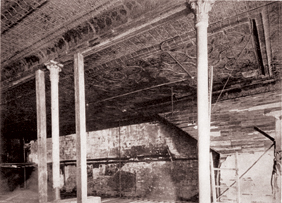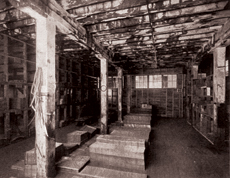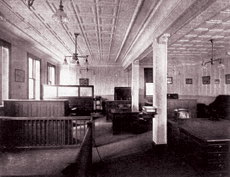Fire rating
Steel Ceiling a Fire Retardent
This illustration is from an actual photograph of a store room after a disastrous fire, at Davenport, Iowa. Please note the effect of the plaster side walls, where the fire has exposed the lath, the metal ceiling remaining intact, confining the fire to the lower floor, and saving the building from destruction.
Much has been claimed for steel ceilings as a fire retardant and to get definite authentic information on this subject, an official test was made by The Columbia University Fire Testing Station at Greenpoint, Brooklyn, New York, November 11, 1914, under the auspices of the Fire Underwriters. Steel Ceilings resisted 1,369 degrees Fahrenheit for over one hours and ten minutes, the entire duration of the test. The wood and plaster ceilings collapsed in twelve minutes after the fire was started, the heat having risen only to 849 degrees. This determined conclusively that superiority of steel ceilings and the fact that they would remain in place five or six times longer that wood lath and plaster ceilings under the intense heat.
The advantages of Steel Ceilings over wood and plaster are apparent. They give almost perfect protection against fire, water, dust, vermin and rodents; they do not crack and never shrink, warp, peel or fall off.
Steel Ceilings and Side walls completely satisfy the need for a non-combustible, decorative and durable finish for all buildings, whether public, churches, theatres, court houses, business blocks, shops, garage and especially for private residences.
The development and expansion of the Steel Ceiling industry in the past twenty years proves conclusively that the Architect, Contractors, Owners, and the Public generally have been quick to appreciate and utilize the advantages of Steel for Ceilings and Side Walls which combine ornamental features with perfection in construction and durability in service. Steel Ceilings are not only the proper protection of the new buildings but are being used quite extensively to replace other types of Ceiling, such as plaster and wood, due to their superior advantages and appearance.
The accompanying illustrations from the actual photographs not retouched; show the wonderful improvement that was made in the appearance, and the usefulness of and old water streaked warehouse which was converted into a modern business office by covering the rooms with “Canton Line” Steel Ceiling and Side Walls. This is only one of many instances where changes of this nature have been made possible by using the modern interior finish.
Old stables have been transformed into attractive dance halls and garages, warehouses into theatres, dirty, dingy rooms into attractive restaurants and confectionery shops – thereby increasing the revenue from these rooms 100 percent to 300 precent.
Where steel ceilings are used, alterations are readily and easily made, or old parts replaced without difficulty.
Steel Ceilings can be put on over old plaster without removing the plaster, avoiding the necessary confusion, dirt and annoyance, where ceilings are to be replastered or repaired.
After





